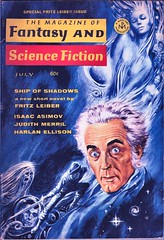 Image via WikipediaTarzan and the Jewels of Opar is the fifth of twenty-five volumes that Burroughs wrote. It is available freely at Gutenberg.org.
Image via WikipediaTarzan and the Jewels of Opar is the fifth of twenty-five volumes that Burroughs wrote. It is available freely at Gutenberg.org.Initially, I found it laborious to trench through the text. This is for the simple reason that Burroughs' portrayals of the villains are simply dull and lifeless. They are such bad people. Tarzan and his kin are of course wholly good. And, when Tarzan's actions might be interpreted as bad, Burroughs makes sure that we understand it is because of his primitive instincts.
It might behoove me to point out that there is a subtle tone of racism to the text. However, while at one moment I might be convinced that he is degrading black people, in the next he will place the white man and his civilization on a rung directly below it. The savage black man is only eclipsed by he who was raised by a particularly advanced primate that can be described as a gorilla sized bonobos, Tarzan himself.
Tarzan goes on a raiding mission to despoil a hidden people, the people of Opar, of much gold and some gems. In his efforts, he manages to suffer amnesia after being hit by a falling rock caused by an earthquake. Meanwhile, his home is obliterated, his wife stolen, and Tarzan is presumed dead. As his memory is gone, he reverts back to his primitive self.
 Image via WikipediaTwo evil Arab groups of men vie to take possession of both Tarzan's wife and the treasure he himself had stolen from Opar. Between the fighting of the Arabs, the mischief of one European who had caused much of the calamity for Tarzan and Jane, Werper, Jane and Tarzan's wife jump between the Arabs. The Arabs are very much portrayed in a negative light. However, considering that most Caucasians are also portrayed in a negative light, perhaps it is not necessarily a racist portrayal. That is to say, everyone who goes to Africa from the west does so to loot the continent.
Image via WikipediaTwo evil Arab groups of men vie to take possession of both Tarzan's wife and the treasure he himself had stolen from Opar. Between the fighting of the Arabs, the mischief of one European who had caused much of the calamity for Tarzan and Jane, Werper, Jane and Tarzan's wife jump between the Arabs. The Arabs are very much portrayed in a negative light. However, considering that most Caucasians are also portrayed in a negative light, perhaps it is not necessarily a racist portrayal. That is to say, everyone who goes to Africa from the west does so to loot the continent.Needless to say, in the end, Werper dies mysteriously at the end, while the two Arab leaders and their followers are largely killed and destroyed. The gold and jewels are all returned back into the possession of Tarzan.






